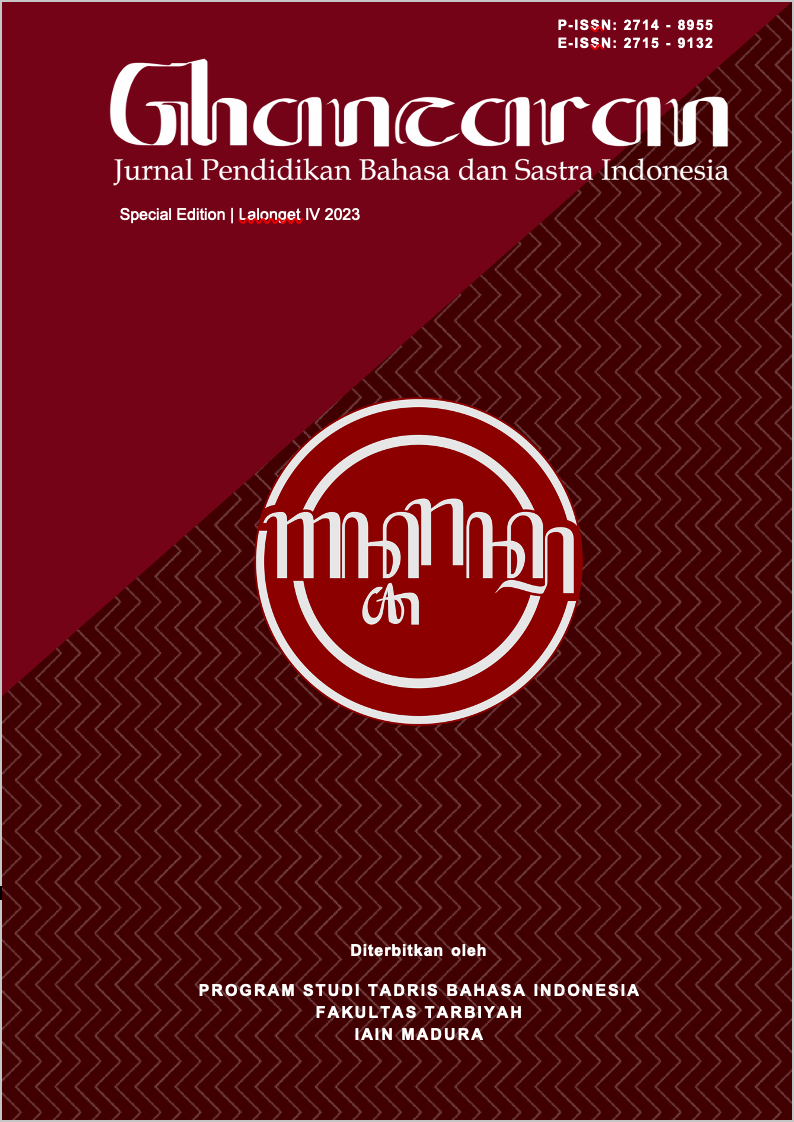Media Elegant Teleprompter sebagai Alternatif Media Pembelajaran Membaca Teks Berita Siswa Kls VIII MTs Nurul Yaqin Proppo
 Abstract views: 263
,
Abstract views: 263
,
 PDF downloads: 268
PDF downloads: 268
Abstract
Obstacles in reading news are the demand to read aloud and the speed of the eye in maintaining focus. This research is to describe the use of the elegant Teleprompter as an alternative learning medium for students to read news texts. The research uses descriptive qualitative methods. Data collection methods in this research used observation, interviews and documentation. The results of this research are that the use of elegant Teleprompter as an alternative learning media has several stages. These stages include 1. Manufacturing process/steps consisting of how to install, how to use and how to create scripts 2. Implementation, which consists of explaining what Elegant Teleprompter is, practicing and giving directions and 3. Evaluation consisting of suitability for learning media, weaknesses and lack.
Downloads
References
Khilmiyah, Akif. 2016. Metode Penelitian Kualitatif. Samudra Biru.
Kustandi, Cecep, and Daddy Darmawan. 2020. Pengembangan Media Pembelajaran: Konsep & Aplikasi Pengembangan Media Pembelajaran Bagi Pendidik Di Sekolah Dan Masyrakat. Prenada media.
Moleong, Lexy J. 2014. ‘Metode Penelitian Kualitatif Edisi Revisi’. Bandung: PT Remaja Rosdakarya.
Morissan, M A. 2010. Jurnalistik Televisi Mutakhir. Kencana.
Muhsyanur, M P, and M Pd. 2014. ‘Membaca (Suatu Keterampilan Berbahsa Reseptif)’. Yogyakarta: Buginese Art.
Muslimin, Khoirul. 2019. Jurnalistik Dasar: Jurus Jitu Menulis Berita, Feature Biografi, Artikel Populer, Dan Editorial. UNISNU PRESS.
Ni’matuzahroh, SPMS, and Susanti Prasetyaningrum. 2018. Observasi: Teori Dan Aplikasi Dalam Psikologi. Vol. 1. UMMPress.
Nurrita, Teni. 2018. ‘Pengembangan Media Pembelajaran Untuk Meningkatkan Hasil Belajar Siswa’. Jurnal Misykat 3 (1): 171–87.
Nuryanto, Hery. 2012. Sejarah Perkembangan Teknologi Informasi Dan Komunikasi. PT Balai Pustaka (Persero).
Rahmawati, Fitri Puji, Dini Restiyanti Pratiwi, and Hari Kusmanto. n.d. KONSEP DASAR BAHASA INDONESIA SEKOLAH DASAR. Muhammadiyah University Press.
Rasyid, Abdul, and Ahmad Tamrin Sikumbang. 2022. Membongkar Kebohongan ISIS Melalui Berita. Academia Publication.
Rodin, Rhoni. 2021. Informasi Dalam Konteks Sosial Budaya-Rajawali Pers. PT. RajaGrafindo Persada.
Sakila, S Pd. n.d. Media Pembelajaran Bahasa Indonesia Di SMP. GUEPEDIA.
Suryadi, Ahmad. 2020. Teknologi Dan Media Pembelajaran Jilid i. CV Jejak (Jejak Publisher).
Susilana, Rudi, and Cepi Riyana. 2008. Media Pembelajaran: Hakikat, Pengembangan, Pemanfaatan, Dan Penilaian. CV. Wacana Prima.
Yandryati, Jenny, Gumono Gumono, and Agus Joko Purwadi. 2017. ‘Kemampuan Membacakan Teks Berita Pada Siswa Kelas VIII 1 SMP Negeri 3 Kota Bengkulu Tahun Ajaran 2016/2017’. Jurnal Ilmiah KORPUS 1 (1): 68–72.
Zainiyati, Husniyatus Salamah. 2017. ‘Media Pembelajaran PAI: Teori dan Aplikasinya’.
Rahman Taopik, Ari Riska Wulandari Aji Abdullah Napi Al As, Aziz Ujang Pahmi Abdul. (2023). Media Digital Untuk PAUD (Teori dan Aplikasi). Tasikmalaya: Edu Publisher.
Sari Naca Yolanda, Gusliana Evi, Puspitasari Tuti, Muslihudin Muhammad. (2023).E-learning sebagai media pembelajaran inovatif,I ndramyu: Penerbit adab.
Copyright (c) 2023 GHANCARAN: Jurnal Pendidikan Bahasa dan Sastra Indonesia

This work is licensed under a Creative Commons Attribution-ShareAlike 4.0 International License.
Ghancaran: Jurnal Pendidikan Bahasa dan Sastra Indonesia uses an Open Access Policy under the Creative Commons Attribution-ShareAlike 4.0 International License. Authors publishing in this journal agree to the following terms:
- Ghancaran Journal holds the copyright and grants the journal rights for first publication with the work simultaneously licensed under a

The work is distributed under Creative Commons Attribution-ShareAlike 4.0 International License which allows others to share, copy, and redistribute the material in any media or format and adapt, remix, change, and develop the material even for commercial purposes, as long as it is stated credit and license derivative works under similar terms. - Authors may make additional contractual arrangements for non-exclusive distribution of the journal's published work version.
- Authors are permitted to post their work online (e.g., in institutional repositories or on their websites) before and during submission, as doing so may lead to productive exchange.



















